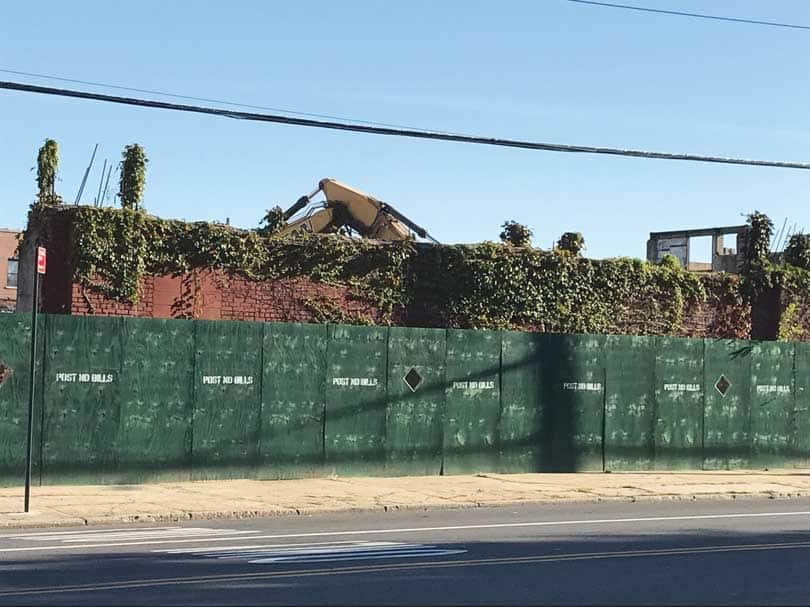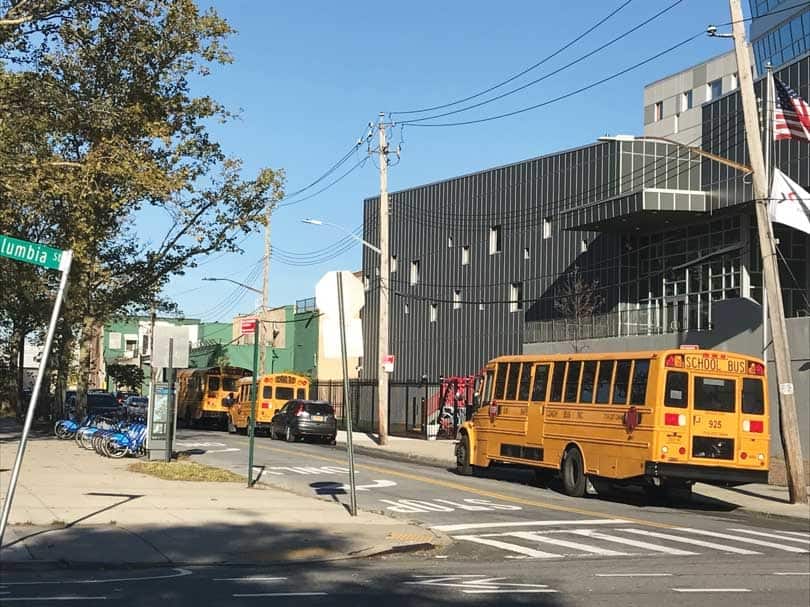
As reported last month, Red Hook Civic Association co-president John McGettrick informed residents that three giant warehouses will be built in Red Hook. One will be located at 537-555 Columbia Street, just northeast of the BASIS Independent School; another at 640 Columbia Street, just south of BASIS Independent and next to IKEA; and the third at the old White Rock/Snapple building, which will be torn down and rebuilt as a state-of-the art UPS facility. The million square feet of new warehousing would most likely create more truck traffic and air pollution.
“I would assume that the new sites on Columbia Street may well have to do environmental testing and cleanings,” McGettrick said during meeting on September 26. “So we’re probably looking at a year to two-and-a-half years down the road when something is actually opening.”
Passers by will have already noticed the demolition of the old dye factory on Columbia and Bay, a block formerly owned by the local plumbing and contracting company, T. Moriarty & Son. The factory, H. Kohnstamm, fell upon hard times in the 1970’s, losing one of their prime products, Red Dye # 2, which was outlawed in 1976.
Trucks and Traffic

Jo Goldfarb, director of communication at BASIS Independent Brooklyn, attended that meeting and voiced her concerns, from both neighborhood and academic perspectives. She spoke with this paper two weeks later, elaborating on what could happen and what would need to be considered for the future – especially with those warehouses slated nearby BASIS Independent Brooklyn.
“It certainly would change traffic patterns and we stand by what McGettrick called for, which is just the appropriate studies, due diligence on the impact of these two new warehouses, on the anticipation of the increase in traffic, and what – if any – impact on emissions in the community.”
In the meantime Goldfarb’s goal is to find some way to connect with the warehouse owners, since the buildings are within a school zone.
“As with any business in the neighborhood, we would welcome the opportunity to work with the owners of the warehouses on when we see the most traffic at arrival and at dismissal,” she added.
Naturally the streets surrounding the school, located at 556 Columbia Street, are the busiest in the mornings for student drop-offs and in the afternoons for pick-ups. While planned traffic routes to and from the warehouses are still undetermined, Goldfarb pointed out trucks would also have to watch their speed limits from Creamer to Halleck Streets.
“We definitely want to work well with our neighbors. We came into this neighborhood and made sure we had the proper people outside directing traffic during arrival and dismissal, so there wouldn’t be congestion,” she said. “We’re committed to continuing that and would hope that any new additions to the neighborhood would also try to work well as a community together.”
Another concern Goldfarb has regards increased foot traffic from the whole community to the various ball fields, which are anticipated to fully open by Spring 2023.
“By the time these warehouses finish there needs to be thought about how many trucks [are driving] and how many kids are crossing the street,” she said. “Right now we don’t have a huge number of children crossing the streets to those fields, but – once they’re open – I would imagine that many directions would need to be considered.”
Brooklyn Heights Promenade Closure
The Brooklyn Heights Promenade could be closed for at least five years, beginning in 2021, while the city reconstructs a 1.5-mile stretch of the Brooklyn-Queens Expressway. McGettrick also explained during the September meeting that the closure and reconstruction could take between five and six-and-a-half years, if the promenade’s completely closed. Another option on the table is to reconstruct the expressway one lane at a time, which would take six-and-a-half to seven years to complete. Either way, Red Hook and other neighborhoods would have to deal with more vehicular traffic and congestion.
McGettrick had brought up that he hopes the warehouse owners are aware of this major closure and change. Goldfarb thought that was a valid point to make and bring up, as this is the time to start talking about all these aspects.
One-Way Street Outside of BASIS

Sigourney Street, between Otsego and Columbia Streets, currently is a two-way road. Goldfarb explained to this paper that the flow of traffic in the mornings and afternoons typically goes down from Columbia to Otsego – with so little traffic going in the opposite direction. As a result, she said drop-offs and pick-ups often get congested with four different vehicles sometimes in motion outside the school.
“We have children and parents crossing quite a bit in the morning and the afternoon and, to have the two-way street, it made it more challenging to focus on,” she said.
BASIS Independent Brooklyn talked to their neighbors down the street about the traffic, and sent an official request to CB6 for Sigourney Street to become one-way, instead of two-way, in September.
The motion to make the street one-way westbound unanimously passed at last month’s general Community Board 6 meeting held on October 10.
“I’ve actually been the crossing guard out there many mornings, so to have one less direction to worry about will be helpful,” Goldfarb said.
Author
-

George Fiala has worked in radio, newspapers and direct marketing his whole life, except for when he was a vendor at Shea Stadium, pizza and cheesesteak maker in Lancaster, PA, and an occasional comic book dealer. He studied English and drinking in college, international relations at the New School, and in his spare time plays drums and fixes pinball machines.
View all posts
George Fiala has worked in radio, newspapers and direct marketing his whole life, except for when he was a vendor at Shea Stadium, pizza and cheesesteak maker in Lancaster, PA, and an occasional comic book dealer. He studied English and drinking in college, international relations at the New School, and in his spare time plays drums and fixes pinball machines.









